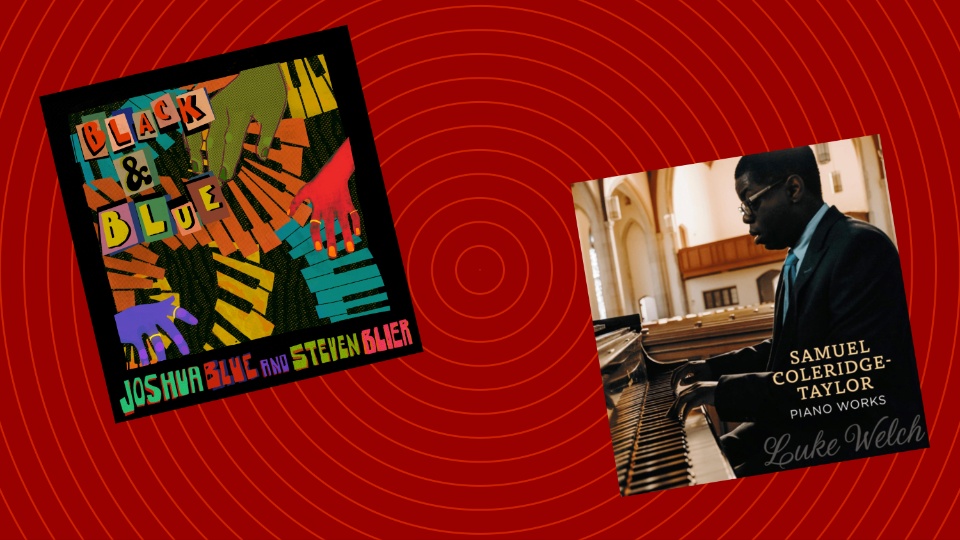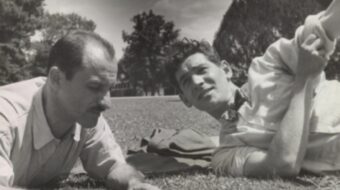
Today we’ll give a listen to two new albums documenting the Black experience—one by an African-British composer who was famous in his day and has lately experienced something of a comeback in the affirmative search for Black roots and representation. And first:
A world-class opera star sings the blues
“In the winter of 2017, many of us were still reeling from the recent election,” writes Steven Blier, pianist, coach and longtime founder/leader of the New York Festival of Song (NYFOS). “In response, I was planning a Juilliard show simply called PROTEST, a program of songs from many countries that put the growing Black Lives Matter protests into the long history of artist activism. I cast Joshua Blue in the vocal ensemble, and asked him to have a look at ‘Black and Blue’ by the legendary ‘Fats’ Waller. Josh was new to Juilliard, politically progressive and outspoken, and I didn’t know how his 21st-century sensibility would respond to the complexities of Andy Razaf’s 1929 lyrics. Josh brought it into a coaching session, and proceeded to deliver a stunning first reading that left me speechless.” Blier goes on to relate the further story of that song, which involves mobsters and guns.
“After Josh Blue sang it that day, I joked, ‘You know, “Black and Blue” would be a great title for our first CD.’ We laughed—but when we launched NYFOS Records in 2021, ‘Black and Blue’ rose to the top of the wish list.”

That song speaks openly of racism, discrimination, “othering.” “My mark of Ham seems to be a curse,” Razaf wrote, referencing one of the sons of Noah from the Bible, whose progeny supposedly went on to establish the Black African race (a common interpretation that slaveholders and segregationists frequently asserted). “What did I do to be so black and blue?” How could Joshua Blue’s first album not incorporate that song—and that title?
A repertoire of songs steadily grew as the collaboration continued. One “intersectional” NYFOS program centered Harlem’s thriving mid-20th-century gay scene; another was devoted to composer and publisher W. C. Handy. Two of the songs uncovered for those programs, “Negrita” and “Freedom Train,” are recorded here for the first time.
“Negrita” is a sensual rumba by Mexican-born Al D’Artega, with Handy’s lyrics. In his time D’Artega was successful as a pops conductor (Carnegie Hall with the New York Philharmonic and concerts for Radio Italiana in Milan and Rome). Fun fact about him: His most famous achievement—that no one connects with his name—is the three-note NBC chime (1-5-3).
“Langston Hughes’s 1947 poem ‘Freedom Train,’” Blier recounts, “took its inspiration from a project proposed by then-Attorney General Tom C. Clark, who felt that American morale needed a boost in the post-war era. He formed a board of directors and loaded a number of important American documents onto a red, white, and blue train that toured the 48 states. Using the services of an advertising firm, they aimed to ‘sell America to Americans.’ People across the country could look at a letter from Christopher Columbus, the Emancipation Proclamation, and documents of the German and Japanese surrender at the end of World War II. Avoiding anything that could cause controversy, they presented artifacts aimed at uniting the crowds that came through the train.
“Those crowds were integrated almost everywhere the train stopped, but Birmingham and Memphis refused to allow Blacks and whites to mingle. This set off enormous controversy, and inspired Langston Hughes to write his poem. The composer Thomas Hayward (best known for his song ‘Honey Man’) set Hughes’s words to music in a familiar American ballad style.The song was never recorded, nor is there any record of a performance since its publication. But when Joshua Blue and I premiered ‘Freedom Train’ in 2019, the song brought down the house. The vivid message about voting rights and equality, combined with the simple authenticity of the music, struck a profound note with the audience. ‘Freedom Train’ may have waited 73 years for its first performance, and another four years for its day in the recording studio, but it has lost none of its power.”
These are but two of the 13 songs on the CD. Some others will be familiar to music lovers, but many are rarer items.
Well-known will be Paul Simon’s 1975 “American Tune,” which pleads for “some rest” “so far away from home” as a reaction to the betrayal of democracy in the Richard Nixon years. “What’s gone wrong?” Simon asks.
Another song many readers will recall well is Lewis Allan’s 1937 “Strange Fruit,” popularized by Billie Holiday. Music historians never fail to mention how devoted the singer was to that terse, graphic number about lynching in the Deep South. Often asked to drop it from her repertoire, she refused, and she attracted the attention of J. Edgar Hoover’s G-men, who hounded her relentlessly. Sadly, as millions protest to demand an end to police and vigilante killing in America, it remains an all too relevant entry in the American songbook. The composer-lyricist worked under the name Lewis Allen, but his daytime name as a New York City public school teacher was Abel Meeropol. He and his wife Anne adopted the two Rosenberg boys after their parents’ 1953 execution, which is why they are named Robert and Michael Meeropol.
Stevie Wonder’s 1972 song “Big Brother,” also from the Nixon years, has an explicit political message as the album opener. The title comes, of course, from George Orwell’s novel 1984. As the Vietnam War continued to rage, as the body bags kept up their grievous caravan home, as our ghettos burned, Wonder delivered a gut-punch with graphic lyrics. “You killed all our leaders,” the songwriter declaims, “You caused our own country to fall.” Denouncing official lies, he was already predicting the collapse of an advanced civilization. His foresight sounds almost mystical now. Could he have imagined people like Donald Trump, Kevin McCarthy, Josh Hawley, Clarence Thomas, Marjorie Taylor Greene, Ron DeSantis one day, not that far off, holding the reins to American governance with forces like the Koch Brothers and Rupert Murdoch pulling their strings? On this tune, Blue ends with an instrumental chorus of humming that brings this device to a new artistic level.
Another W.C. Handy song is the 1914 “Yellow Dog Blues,” an “answer” song to a popular number from the year before, Shelton Brooks’s “I Wonder Where My Easy Rider’s Gone.” It speculates on the present whereabouts of a vagrant lover with rumored sightings all across the South. A listener could imagine a man riding the rails, looking out the window, and happening to witness the scene in the next song in the album sequence, the shocking “Strange Fruit” hanging from Southern poplar trees.
On that gay Harlem program, Blier and his performers gave tribute to the long-forgotten, but only recently rediscovered cross-dressing Harlem chanteuse Gladys Bentley, who lamentably left no recordings to posterity. Her song “Red Beans and Rice” honors the hardworking woman tired of her cheap, simple diet, but it’s all she could afford to eat, with only some “greasy bacon in the pot” once in a while. She had to give most of her pay to “the man,” “morning, noon and every night.” The implication is that her “man” was either her lover or her pimp—perhaps the “Yellow Dog’s” “easy rider.” Blue does not change the pronouns for his lost lover.
One number is completely in Spanish, the Argentinean María Elena Walsh’s 1972 “Como la cigarra” (Like the Cicada). Throughout all the ups and downs of life, the lyrics say, “seguí cantando, cantando al sol, como la cigarra”—I kept on singing, singing to the sun, like the cicada. How like the African-American spirituals that kept people’s hopes and dreams alive during the bitterest of times. I don’t know of any operatic roles Blue may have performed in Spanish, but his pronunciation here is perfect and artful.
Blue’s debut CD would not be complete without a couple of spirituals. Early on we hear Hall Johnson’s arrangement of “Ride On, King Jesus” in a strapping new version, and later Moses Hogan’s setting of “Walk Together, Children,” with Blier’s own ecstatic piano playing.
And we also have a couple of love songs. The gay musician and songwriter Billy Strayhorn, longtime collaborator with Duke Ellington, wrote “Day Dream” in 1939, a sensual melody set to a lyric by John LaTouche (of Ballad for Americans fame) that perfectly fits an Ella Fitzgerald type of voice. It’s been recorded many times—in fact, by Ella herself in 1957. I had the distinct feeling that Blue modeled his delivery on her performance. Another thing struck me immediately: The song inhabits a harmonic and melodic universe that I feel sure Kurt Weill must have heard and appreciated, for it sounds as though it could have come right out of Weill’s 1949 musical theater work Lost in the Stars, based on Alan Paton’s South Africa-based novel Cry, the Beloved Country. “Day Dream/ Don’t break my reverie/ Until I find that he/ Is day dreaming just like me.” That last verse is repeated—the first time it definitely sounds like “he,” the second time like “she.” Inclusive editing?
To finish off the CD, Harry Warren’s “At Last”—“At last/ My love has come along/ My lonely days are over/ And life is like a song.” Not to take anything away from it as a love song, but following the previous 12 songs on Black & Blue, it can also be heard as an aspirational love of country that has finally risen above its many prejudices and awakened to its senses. “I found a dream that I could speak to/ A dream that I can call my own…You smiled, you smiled/ Oh, and then the spell was cast/ And here we are in Heaven/ For you are mine at last.”
In his program note, Blier explains how “At Last” came to be included on the disc. Perhaps my speculation that this song meant more than just another love song was correct. Blier quotes the singer:
“When I was a senior in high school [in Aurora, Illinois] they had a competition à la Miss America, called ‘Mr. WVHS’ (Waubonsie Valley High School). For the talent portion of the competition I decided to play and sing ‘At Last.’ Being the person I am, I chose to perform it in drag: a kitten heel, sparkly blue dress, earrings, and a short blonde wig adorned my person, underneath a big pink fuzzy bathrobe (because we love a reveal!).
“It was my first time experimenting with understanding who I am, playing with gender, picking music that I wanted to sing because I wanted to sing it, not because I was told to. If I had to pick a moment in my life that could be considered the start of my artistic journey I think that would be it. It was the first time I made music for the sake of making music, nothing more, nothing less.”
Blue performs leading tenor roles in opera houses all over America, but chose not to introduce himself to the recorded world with a selection of opera’s most famous tenor arias. Instead, he says, he wanted “a celebration of the music that shaped me as an artist before opera was even a blip on my radar. These are the songs and musical styles that helped make me…well, me.” Blue promotes himself as “British-American,” but there’s nothing in his website bio that explains this.
Black & Blue’s 13 numbers, over the span of 49 minutes, paint a portrait of an America many listeners may not know well. These songs ask us to pay closer attention.
Blue’s voice is absolutely enchanting—so versatile, flexible, expressive. And we hear him in an unaffected setting, outside the staid opera house, in repertoire that grants him the freedom to explore, bend a note, get bluesy and fly. His dedication is appropriately touching: “to my first voice teacher, Dr. Jennifer Barnickel-Fitch, who taught me the most important lesson of my career: Be yourself, always.”
He is joyfully accompanied not only by Steven Blier on piano but also by Chris Benham and Jay Sawyer on percussion, Vince Giordano and Will Slater on bass, Alex Levine on guitar, Jasim Perales on trombone, Oskar Stenmark on cornet and trumpet, and Jason Yeager on Fender Rhodes. The CD was recorded in Brooklyn in early November 2022. For more information about the New York Festival of Song, go to www.nyfos.org. Joshua Blue’s website, including several clips of him singing, can be looked at here.
Black & Blue
NYFOS Records, 2023
Revisiting Samuel Coleridge-Taylor
Meanwhile, over two days at the end of November 2022, award-winning Toronto-based pianist Luke Welch sat in an unidentified church (in Toronto presumably), to record a 55-minute, privately released CD homage to the gifted and once-famous African-British composer Samuel Coleridge-Taylor (1875-1912), whose work is thankfully achieving a certain renaissance in the age of Black Lives Matter. The album was produced with the support of the City of Toronto through the Toronto Arts Council Black Arts Project.
Coleridge-Taylor was born in London of a Black African father and white English mother. Early on he decided not to run away from race but to embrace his dual heritage. He researched all varieties of African music, most significantly that of the African Americans in slavery times and beyond. He made several visits to the United States. The occasional blue note graces a few of the piano pieces reviewed here.
As a conservatory-trained musician and conductor who aspired to be accepted into the ranks of respectable British music, he drew heavily on Negro spirituals in his quest for an ethnic, national language (in the same way the Czechs, Hungarians, Russians and others explored their native folk heritage). He was highly taken by the Fisk Jubilee Singers whom he heard on tour in 1899. He did not appreciate the up-and-coming ragtime and jazz movements. No doubt, if he had lived longer he would have seen, and would have been pleased, that these fresh contributions to world music had won fans among many “serious” composers both in America and in Europe.
The music featured here derives from the composer’s more classically oriented catalogue. For the most part it can be characterized as “light” music that might contrast well on a heavier program of Mozart, Liszt or Beethoven, especially if played as an encore to send audiences home with a smile on their faces. Perhaps “salon” music might be the appropriate term—not to diminish it, for there is certainly a place for that, but just to situate it in the musical orbit and to signal that listeners should come to it without grandiose expectations of either great virtuosistic or soul-searching profundity.
These five works do not exhibit the composer’s fascination with African-derived music, at least not that I could hear, except perhaps in the second movement of “Scenes from an Imaginary Ballet,” where I think I caught some inspiration from the African-American spirituals. The album has a kind of “documentary” feel to it, a heartfelt tribute to a beloved ancestor and role model which acknowledges these as a few of his lesser achievements. Without exception, these are minor entries in the vast piano literature, yet not insignificant considering their provenance. They are tuneful and sweet, recalling sentimental popular music of the turn of the 20th century. Most have a song structure, and I could well imagine a lyricist setting words to some of them.

The “Scenes” are the first piece on the program, with five movements. The merry tune of the first movement is set off by the “spiritual” of the second (if I heard that correctly), a bright minuet that follows, next a Victorian-era ballad, and concluding with a somewhat more dramatic, syncopated showpiece. Later in the album I would become more sensitized to this, but not having heard any of this music before, still I wonder about Welch’s tempos. In this first piece, movement one is “molto vivace” (very lively or fast) and the last is “vivacissimo” (really, really fast), but Welch’s tempos are considerably more sober.
The “Three Humoresques” that follow sound Grieg-like to me, sprightly confections with slight chromatic touches, a picaresque smirk, and a lot of tickling the keys. But all three are too long for their own good. Whatever humor the composer had intended wears off quickly. Here again, part of the problem is tempos—the first is “presto” (fast), and the second is another “molto vivace,” but the pianist has a decidedly moderate interpretation of those terms.
Items three and four are single-movement pieces. “Intermezzo,” at 5:17, with its rolled chords, its important-sounding processional statement, made me think, intermezzo between what? Acts of an opera or play, like the intermezzo between scenes of Cavalleria Rusticana? And then it occurred to me that’s exactly what it sounded like, in a skillful piano reduction. I don’t know Coleridge-Taylor’s full catalogue, but if there isn’t an orchestrated version of this piece, frankly I believe that would be a fine piece of music.
For musical satisfaction I found the fourth number, “Papillon,” the most successful, though short at 3:24. We hear the fast-fluttering wings of the butterfly, rising and falling as s/he flits dance-like from bud to bud. The middle section is a calm, relaxed interlude with a few smoky blue notes—the butterfly poised, their wings in a slow waving motion—and then a reprise of the exciting flutter motif with a grand finale as s/he disappears out of view.
The final piece on the program is “Valse Suite, Three Fours,” with six dances in 3/4 time ranging from the shortest at 2:03 to the longest at 3:58. They capture different moods, some more than others giving off images of actual choreography to accompany them. The second is poignant but predictable, the third is in my view the best with its overtone of expectancy ending with something like an announcement of fate, the fourth, again not played especially “vivace,” has the feel of a contemporary Ivor Novello or Noël Coward song.
What I missed across these 16 tracks was more rhythmic vitality, and that thrill listening to flying fingers and feeling amazed how anyone can do that! It is a much appreciated gesture on Welch’s part to record and disseminate Coleridge-Taylor’s piano works, though I’m not convinced these can be considered definitive interpretations. But truly, bravo for this mostly successful effort!
Luke Welch’s website can be accessed here. There you will find one of his podcasts devoted to Samuel Coleridge-Taylor, and further information about this and his other recordings.
Samuel Coleridge-Taylor Piano Works
Luke Welch, pianist
We hope you appreciated this article. At People’s World, we believe news and information should be free and accessible to all, but we need your help. Our journalism is free of corporate influence and paywalls because we are totally reader-supported. Only you, our readers and supporters, make this possible. If you enjoy reading People’s World and the stories we bring you, please support our work by donating or becoming a monthly sustainer today. Thank you!










